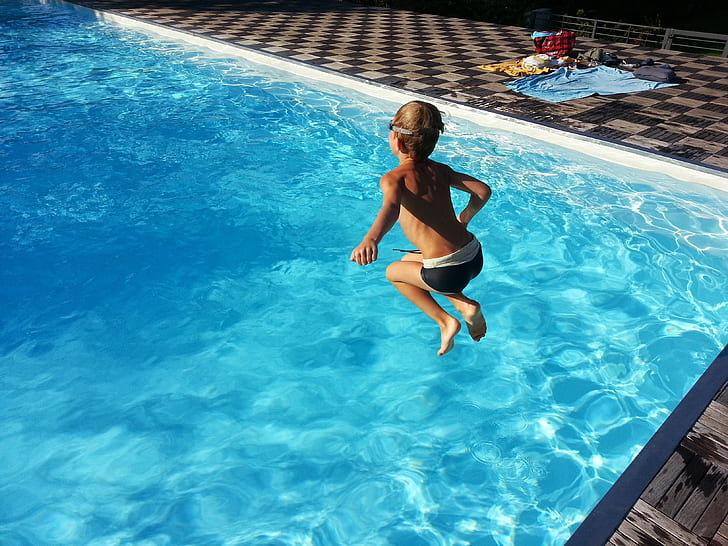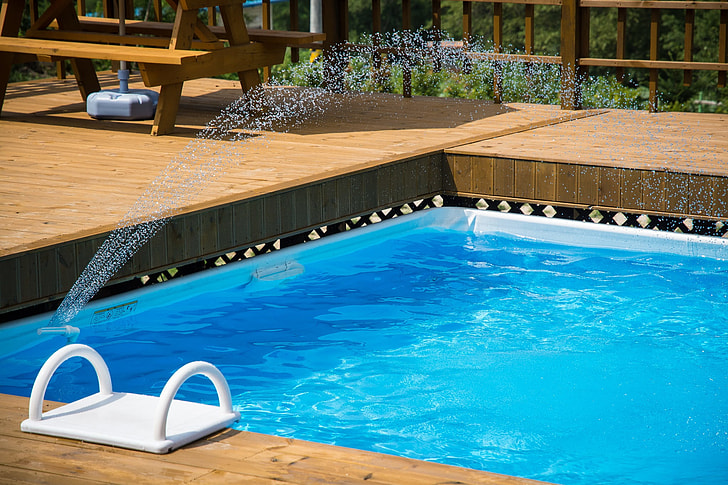A swimming pool in the home garden can be a good way of improving your quality of life, especially for families with children. The initial investment can be considerable, but over time, it will reap benefits. Bear in mind, however, that a built-in pool doesn’t necessarily add value to your house. Prospective future buyers may have no need or desire for a pool. Therefore, before you start renting a digger, be sure that you will make good use of a pool. If you don’t use it enough, it is simply a big hole in your garden.
In Slovenia, the school holidays begin at the end of June / beginning of July. However, June can be very warm and the kids will be glad to cool off when they get home from school. When you weigh up the initial costs of a pool and maintaining it with the costs of admission to a public pool, transport and snacks for a family, the financial benefits of a home pool soon become apparent. Besides the financial advantages, a home pool gives you privacy, convenience and the possibility of familiarising young children with the water. Being able to cool down on the hottest days is also appealing to all generations.

There are a few types of above-ground pool.
- Inflatable – these are typically the cheapest type of above-ground pool and the easiest to assemble. You inflate the top ring and then begin filling the pool. As you add water, the top ring begins to float allowing the walls to expand into the size you purchased.
PROS: Inflatable pools are also the easiest to move around your garden. They come in quite shallow depths so are good for families with young children.
CONS: Such pools can be trickier to keep clean, and you may need to drain and refill them frequently. Also, the pool wall can tear easily, causing the pool to leak. You will be lucky if your inflatable pool survives more than a couple of summers.
- Steel frame pool– this style has a steel frame consisting of a top rail, upright pool posts, and some type of footing. The frame is easy to assemble as the components snap together with pins to provide the structure for the pool liner.
PROS: Quick and easy to assemble, can be shifted around the garden. Lots of size options to suit your family and size of the space available.
CONS: The additional items that come with your steel frame pool may not be good enough quality. As a result, you may have to replace or upgrade the pump, ladder or filter. Also, steel frame pools are not intended to be left up year-round, though you may see lots of home owners in Slovenia who do just that. This will reduce the lifespan of your pool.
- Traditional above-ground pool – these pools have a separate pool wall and structure. The wall is made from resin or metal, while the liner comes in a variety of materials.
PROS: Can be assembled in around a day. Can be dismantled and then reassembled if you move house. Because they are higher quality, and more expensive, the additional equipment will be better and last longer. With careful maintenance, these pools can last as long as 20 years. Once erected, they are intended to stay up year-round, thus saving you time.
CONS: The traditional above-ground pool requires ground preparation and work to install electrical connections for the pump/filter.
Semi in-ground pools – can be installed as an above-ground pool, partially buried or completely buried. These pools are similar to traditional above ground pools but the main difference is that they come with a fully insulated wall panel.
PROS: the much stronger wall panels allow for ground forces. Therefore, they can be fully buried to resemble an inground pool. Furthermore, they come in freeform designs, perfect for anyone who wants something a bit different. They cost less than a traditional inground pool. Because of their strong walls, these pools can be installed year round.
CONS: Semi-inground pools require a lot of ground preparation prior to pool installation.
Below-ground pools
Below-ground pools are typically seen as a more luxurious option.
PROS: Can be custom-designed to fit your specific needs and preferences. Constructed from a variety of materials, including concrete, fibreglass, and vinyl, making them durable: with the dilligent maintenance, a below-ground pool should last for decades. Depth – in-ground pool can be deeper, so the best choice for those who really want to swim, rather than just splash around.
CONS: Cost – the most expensive home pool option. Groundworks – the works include more digging, this is the only way to prepare for a below-ground pool. This also adds to the cost. Additionally, some ground types may not be suitable for a below-ground pool. Below-ground pools present a greater safety risk for young children as they can walk straight into the water. You may need to also erect a fence or similar around the pool for this reason.
A variety of tools are available that can help ensure the cleanliness of the water in your pool. Filtration systems remove debris and contaminants from the pool water by pushing the water through the filter. Chlorine treatments sanitise the pool water and prevent the growth of bacteria and algae. Robotic pool cleaners are move around the pool and use brushes and suction to remove dirt and debris from the pool floor and walls.
It is important to bare in mind that, despite the tools that can help with pool maintenance, you will still need to do some work yourself. The surface of the water must be skimmed regularly to remove debris, leaves and insects . Brushing the pool walls and floor can also help to prevent algae and other contaminants from building up. Finally, you must test the pool water for pH and chlorine levels, and adjust the levels as needed.
Environmental impact
If the environmental impact of a home pool is holding you back from taking the plunge, consider the following:
Water and energy consumption are reduced to a minimum in modern swimming pools. By ensuring your pool is covered when not in use (overnight, if you are away for most of the day), dirt will accumulate in the water more slowly. Therefore, the water need not be changed as frequently. Covering the pool when it’s not in use will also prevent children climbing in unsupervised.
You can extend the season can by heating the water with a heat pump or solar energy. They are more environment-friendly and cost-effective than other methods of pool heating because they capture the heat from the air and transfer it to the water, rather than generating heat.
If the environmental impact of a home pool still worries you, read our article about natural pools, which are an increasingly popular option.
Having a home pool can bring a lot of joy. Just think of the hours of fun your children or grandchildren can enjoy in a pool at home! However, the decision on which type of pool to choose can be daunting. All of them come with advantages and disadvantages that you should weigh up carefully. Really think about how much you will use your pool and what you will do in it. This will help you understand what kind and size of pool best fits your needs.













